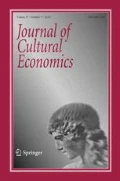Abstract
Expenses in the performing arts have historically increased at a rate faster than earned revenues due to the labour reliance of the sector. Flanagan (The perilous life of symphony orchestras: artistic triumphs and economic challenges. Yale University Press, New York, 2012) found that US symphony orchestras were able to avoid the negative consequences of this earning gap by fostering strong private support. In the present study, we find that, in contexts where private funding is not as readily accessible, like in Canada, arts organizations have more incentive to keep expenses under control. This can be understood in terms of resource dependence where government funding bodies, due to a homogeneous set of demands, put pressure on organizations to control their expenses and reach greater audiences. Using panel data covering a period of 8 years and forty-eight orchestras, the results show that Canadian orchestras, when compared to US ones, achieve a lower rate of expense increases over time and are more reactive to economic downturns.
Similar content being viewed by others
References
Ashenfelter, O. C. (2012). Comparing real wages (working paper). National Bureau of Economic Research. http://www.nber.org/papers/w18006.
Baumol, W. J., Batey Blackman, S. A., & Wolff, E. N. (1985). Unbalanced growth revisited: Asymptotic stagnancy and new evidence. The American Economic Review, 75(4), 806–817.
Baumol, W. J., & Bowen, W. G. (1966). Performing arts: The economic dilemma. New York: The Twentieth Century Fund.
Bennett, R., & Savani, S. (2011). Surviving mission drift: How charities can turn dependence on government contract funding to their own advantage. Nonprofit Management and Leadership, 22(2), 217–231.
Blaug, M. (2001). Where are we now on cultural economics? Journal of Economic Surveys, 15(2), 123–143.
Brammer, S., Millington, A., & Pavelin, S. (2006). Is philanthropy strategic? An analysis of the management of charitable giving in large UK companies. Business Ethics: A European Review, 15(3), 234–245.
Brooks, A. C. (1999). Do public subsidies leverage private philanthropy in the arts? Empirical evidence on symphony orchestras. Nonprofit and Voluntary Sector Quarterly, 28(1), 32–45.
Bussell, H., & Forbes, D. (2002). Understanding the volunteer market: The what, where, who and why of volunteering. International Journal of Nonprofit and Voluntary Sector Marketing, 7(3), 244–257.
Canada Revenue Agency. (2014). General income tax and benefit guide. Accessed October 1, 2015. www.cra.gc.ca.
Colbert, F. (2009). Beyond Branding: Contemporary marketing challenges for arts organizations. International Journal of Arts Marketing, 12(1), 14–20.
Cowen, T. (1996). Why I do not believe in the cost-disease. Journal of Cultural Economics, 20, 207–214.
Davidson, R., & MacKinnon, J. G. (1993). Estimation and inference in econometrics. New York: Oxford University Press.
Felton, M. V. (1994). Evidence of the existence of the cost disease in the performing arts. Journal of Cultural Economics, 18(4), 301–312.
File, K. M., & Prince, R. A. (1998). Cause related marketing and corporate philanthropy in the privately held enterprise. Journal of Business Ethics, 17, 1529–1539.
Flanagan, R. J. (2012). The perilous life of symphony orchestras: Artistic triumphs and economic challenges. New York: Yale University Press.
Froelich, K. A. (1999). Diversification of revenue strategies: Evolving resource dependence in nonprofit organizations. Nonprofit and Voluntary Sector Quarterly, 28(3), 246–268.
Getzner, M. (2002). Determinants of public cultural expenditure: An exploratory time series analysis for Austria. Journal of Cultural Economics, 26(4), 287–304.
Grant, M., & Hettinger, H. S. (1940). American symphony orchestras and how they are supported. New York: W.W. Norton.
Heilbrun, J. (2003). Baumol cost disease. In R. Towse (Ed.), A handbook of cultural economics (pp. 91–101). Northampton: Edward Elgar.
Hsieh, J. (2009). Strategic stakeholder orientations and performance consequences—A case of private non-profit performing arts in the US. International Journal of Nonprofit and Voluntary Sector Marketing, 15, 13–27.
Hutter, M. (1996). The impact of cultural economics on economic theory. Journal of Cultural Economics, 20, 263–268.
Macedo, I. M., & Pinho, J. C. (2006). The relationship between resource dependence and market orientation: The specific case of non-profit organisations. European Journal of Marketing, 40(5/6), 533–553.
Ostrander, S. A. (2007). The growth of donor control: Revisiting the social relations of philanthropy. Nonprofit and Voluntary Sector Quarterly, 36(2), 356–372.
Ostrower, F. (1995). Why the wealthy give: The culture of elite philanthropy. Princeton, NJ: Princeton University Press.
Ostrower, F. (2002). Trustees of culture: Power, wealth, and status on elite arts boards. Chicago: The Chicago University Press.
Pfeffer, J., & Salancik, G. R. (1978). The external control of organizations: A resource dependence perspective. New York: Harper & Row.
Pompe, J., Tamburri, L., & Munn, J. (2011). Factors influencing programming decisions of US symphony orchestras. Journal of Cultural Economics, 35, 167–184.
Schenker, N., & Gentleman, J. F. (2001). On judging the significance of differences by examining the overlap between confidence intervals. The American Statistician, 55(3), 182–186.
Slater, S. F., & Narver, J. C. (1990). The effect of a market orientation on business profitability. Journal of Marketing, 54(4), 20–35.
Towse, R. (1997). Baumol’s cost disease: The arts and other victims. Cheltenham: Edward Elgar.
Weinstein, L. (2010). The design, implementation and management of social alliances for arts- and cultural-oriented organizations. International Journal of Arts Management, 12(2), 31–42.
Author information
Authors and Affiliations
Corresponding author
Ethics declarations
Conflict of interest
The authors declare that they have no conflict of interest.
Rights and permissions
About this article
Cite this article
McGrath, T., Legoux, R. & Sénécal, S. Balancing the score: the financial impact of resource dependence on symphony orchestras. J Cult Econ 41, 421–439 (2017). https://doi.org/10.1007/s10824-016-9271-z
Received:
Accepted:
Published:
Issue Date:
DOI: https://doi.org/10.1007/s10824-016-9271-z




